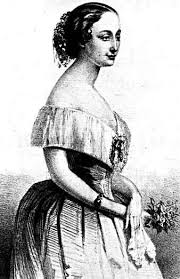Time to enter to win a copy of the book
Entertaining Women:
Actresses, Dancers, and Singers in the Old West
Long before actors were vying for an Oscar nomination and world wide fame thespians were trying to carve out a modest living entertaining prospectors and settlers of the Old West. Today the curtain goes up on a woman entertainer who captured the hearts of the western pioneers.
Ladies and gentlemen, Catherine Hayes, the Irish Prima Donna

A demure ten-year-old girl sat in front of a clear blue river, half hidden under a canopy of willow trees in a lush garden, singing. Her silvery-toned voice resonated across the water and filled the afternoon sky with a melancholy sound. Couples canoeing on the river paddled toward the song, halted their boats, and waited in the shadows of the trees, listening. No one said a word. Not even a whisper gave away their position to the unknowing girl. Indeed she didn’t realize anyone was paying attention until she finished her tune and rapturous applause commenced. Thus was the romantic beginning of Kate Hayes’s singing career.
When Catherine (Kate) Hayes was born in July 1823 in Ireland, her mother, Mary, compared the child’s features to those of a cherub. Her talent for singing like an angel was soon revealed.
Kate’s father, Arthur, abandoned her and her sister when they were small children, leaving the family destitute; consequently, Kate and her sister were forced to go to work as soon as they were old enough. From the age of eight, Kate worked a variety of jobs, from caring for infants to scrubbing inn floors. At nineteen she found employment as an assistant to a charwoman. She sang as she cleaned the homes she worked in, and passersby who overheard her were astonished at her remarkable voice.
Bishop Edmond Knox of Limerick heard Kate singing as he was passing by one of the homes she was cleaning, and he proclaimed that she had the most beautiful voice he had ever heard. He was the first to recognize her potential and consequently took her on as his protégé. Bishop Knox consulted with friends and, along his wife Agnus, helped raise the necessary funds to send Kate to Dublin with letters of introduction to the accomplished vocalist and voice teacher Professor Antonio Sapio.
Professor Sapio agreed to train the young girl, as her voice possessed a clearness and mellowness he had rarely heard before. One month after her arrival in Dublin, Kate made her first formal public appearance at a concert hosted by her instructor. The discriminating audience was impressed by her talent, and the reviews in the newspaper the following day reflected the crowd’s pleasure. Intuitively, Sapio knew his protégé required more specialized training than he could provide and encouraged Catherine to continue her studies in France.
Bearing a letter of introduction from celebrated pianist George Osborne, Kate arrived in Paris in October 1844. Manuel Garcia, a renowned voice instructor who also taught other singers such as Jenny Lind, Maria Malibran, and Henriette Sontag, became her vocal teacher.
Garcia taught Kate everything he could, then sent her to Italy to study for a career in opera. She concentrated on language arts and drama. In Milan, she met many influential theater patrons who arranged for her to audition for Giuseppe Provini, manager of the Italian Opera in Marseilles, France. Provini was so taken by her talent that he scheduled her operatic debut on May 10, 1845, as Elvira in Bellini’s opera I Puritani. She was discovered by an American stage producer shortly after her debut in Italy. The producer quickly whisked her off to the United States.
To learn more about how Catherine Hayes’ singing career began and about the other talented performers of the Old West read
Entertaining Women: Actresses, Dancers, and Singers in the Old West.

